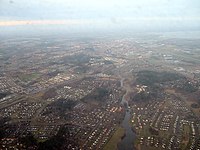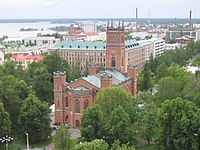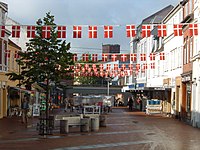List of urban areas in the Nordic countries
From Wikipedia, the free encyclopedia
This is a list of urban areas in the Nordic countries by population. Urban areas in the Nordic countries are measured at national level, independently by each country's statistical office. Statistics Sweden uses the term tätort (urban settlement), Statistics Finland also uses tätort in Swedish and taajama in Finnish, Statistics Denmark uses byområde (city), while Statistics Norway uses tettsted (urban settlement).


A common statistical definition between the Nordic countries was agreed in 1960,[1] which defines an urban area as a contiguous built-up area with a population of at least 200 and where the maximum distance between dwellings is 200 metres, excluding roads, car parks, parks, sports grounds and cemeteries - regardless of the boundaries of the municipality, district or county.[1][2] Despite the common definition, the different statistical offices have different approaches to carrying out these measurements, resulting in slight differences between countries.[a]
The Nordic definition is unique to these countries and should not be confused with international concepts of metropolitan area or urban areas in general. In 2010, Finland (stat.fi) changed its definition. This means that, according to official statistics, the land area covered by urban areas is three times larger in Finland than in Norway, although the total urban population is about the same (ssb.no). It also means that the population of a Danish 'byområder' is usually less than half the population of the 'functional urban area' as defined by Eurostat, whereas the population of a Finnish 'taajama' is usually around 80% of the respective 'functional urban area' as defined by Eurostat. For example, in 2013 the 'functional urban area' of Aarhus had a population of 845,971, while the 'functional urban area' of Tampere had a population of 364,992. However, according to official statistics, the "taajama" of Tampere is larger than the "byområde" of Aarhus (eurostat.ec). This suggests that direct comparisons between Finland and the other Nordic countries may be problematic.
List
Summarize
Perspective
| Rank | City / urban settlement | Urban area | Metropolitan / Eurostat Functional Urban Area | Notes | Image | Country |
|---|---|---|---|---|---|---|
| 1 | Stockholm | 1,611,776 | 2,417,124[3] | Capital of Sweden. Municipality: 978,770. |  | |
| 2 | Copenhagen | 1,366,301[4] | 2,135,634[5] (see notes) | Capital of Denmark. Municipality: 660,842 (2023). |  | |
| 3 | Helsinki | 1,337,786[6] | 1,738,375 | Capital of Finland. Municipality: 684,589. |  | |
| 4 | Oslo | 1,098,061[7] | 1,588,457[8][9] 1,278,827 (Eurostat, 2013, latest available) | Capital of Norway. Municipality: 723 196. The Greater Oslo Region (metropolitan) area has a population of 1,546,706. |  | |
| 5 | Gothenburg | 607,882 [10] | 1,070,935 [11] | Municipality: 599,305. |  | |
| 6 | Aarhus | 367,095[12] | 845,971 | Municipality: 367,095.[13] |  | |
| 7 | Malmö | 357,377 | 707,120[3]
Eurostat: 658,050, 2017. |
Municipality: 328,494. |  | |
| 8 | Tampere | 347,470[14] | 440,372 Eurostat: 369,525. |
Municipality: 260,358. Most populous inland city in the Nordic countries. |  | |
| 9 | Turku | 291,230[14] | 337,751[15] | Municipality: 206,035. |  | |
| 10 | Bergen | 272,125[7] | 420,000[citation needed]395,338 (2013, Eurostat) [11] | Municipality: 285 911. Metropolitan area: 377,116. |  | |
| 11 | Oulu | 257,670[14] | 258,241 | Municipality: 216,194 |  | |
| 12 | Reykjavík |
242,995[16] |
Capital of Iceland. Municipality: 135,688.
Urban area includes all or most of the population of 5 additional municipalities in the Capital region. |
 | ||
| 13 | Stavanger/Sandnes | 239,055[7] | 319,822 |
Municipality: 144 223. Metropolitan area: 297,569.
Conurbation includes the neighbouring municipalities Sandnes, Randaberg and Sola. |
 | |
| 14 | Trondheim | 198,777[7] | 310,052 (2022)[17] 264,396 (2013, Eurostat) |
Municipality: 211,246 |  | |
| 15 | Odense | 178,210[18] | 485,672 | Municipality: 213,558 |  | |
| 16 | Uppsala | 168,096 | 253,704[19] 288,203 | Municipality: 225,164 |  | |
| 17 | Aalborg | 134,672[18] | 580,272 | Includes Nørresundby; Municipality: 205,809 |  | |
| 18 | Jyväskylä | 143,420[14] | 212,500 | Municipality: 149,269 |  | |
| 19 | Lahti | 119,068[14] | 191,460 | Municipality: 121,383 |  | |
| 20 | Fredrikstad/Sarpsborg | 116,373[20] | Fredrikstad: 83 220 Sarpsborg: 57 483 |
 | ||
| 21 | Västerås | 110,877 | 173,322[19] 195,675 | Municipality: 137,207 |  | |
| 22 | Drammen | 109,416[7] | Includes parts of Øvre Eiker, Lier and Røyken. |  | ||
| 23 | Örebro | 107,038 | 208,241[19] | Municipality: 135,460 |  | |
| 24 | Linköping | 104,232 | 177,308[19] | Municipality: 146,416 |  | |
| 25 | Helsingborg | 97,122 | 272,873[19] | Municipality: 129,177 |  | |
| 26 | Porsgrunn/Skien | 92,753[20] | Includes Porsgrunn and Skien and a part of Bamble. |  | ||
| 27 | Jönköping | 112,766 | Municipality: 127,382 |  | ||
| 28 | Kuopio | 88,520[14] | 167,753[19] | Municipality: 125,668 |  | |
| 29 | Norrköping | 87,247 | 183,100[19] | Municipality: 130,050 |  | |
| 30 | Pori | 84,190[14] | Municipality: 83,316 |  | ||
| 31 | Lund | 82,800 | Municipality: 110,488 |  | ||
| 32 | Umeå | 79,594 | Municipality: 115,473 |  | ||
| 33 | Esbjerg | 72,398 | Municipality: 116,032 |  | ||
| 34 | Gävle | 71,033 | 184,346[19] | Municipality: 95,055 |  | |
| 35 | Joensuu | 67,811[14] | Municipality: 78,743 |  | ||
| 36 | Vaasa | 67,690[14] | Municipality: 70,374 |  | ||
| 37 | Borås | 66,273 | Municipality: 103,294 |  | ||
| 38 | Eskilstuna | 64,679 | 209,028[19] | Municipality: 96,311 |  | |
| 39 | Södertälje | 64,619 | - | Municipality: 86,246
No independent area, part of Greater Stockholm[19] |
 | |
| 40 | Randers | 62,687 | Municipality: 98,265 |  | ||
| 41 | Karlstad | 61,685 | 179,486[19] | Municipality: 85,753 |  | |
| 42 | Kristiansand | 112 725 | Municipality: 88,320 |  | ||
| 43 | Växjö | 60,887 | 156.629[19] | Municipality: 83,005 |  | |
| 44 | Täby | 61,272 | - | Municipality: 63,789
No independent area, part of Greater Stockholm |
 | |
| 45 | Kolding | 60,508 | Municipality: 92,515 |  | ||
| 46 | Halmstad | 58,577 | 134,156[19] | Municipality: 91,800 |  | |
| 47 | Vejle | 56,567 | Municipality: 114,140 |  | ||
| 48 | Horsens | 55,884 | Municipality: 85,662 |  | ||
| 49 | Lappeenranta | 55,743[14] | Municipality: 73,369 |  | ||
| 50 | Rovaniemi | 52,753[14] | Municipality: 65,738 |  | ||
| 51 | Kotka | 51,704[14] | Municipality: 50,210 |  | ||
| 52 | Sundsvall | 50,712 | 125,812[19] | Municipality: 96,977 |  |
Note that the population numbers from the countries are from different years, as Statistics Finland, Statistics Norway and Statistics Denmark release the statistic yearly (albeit at different times of the year), Statistics Sweden only release the figures every five years. The Norwegian data is from 2013[20] and 2018,[7] the Danish data is from 2014,[21] the Swedish is from 2010[22] and the Finnish is from 2017.[14]
Also note that some of the statistics have been updated since the first note was made, so some statistics may be from 2018, while others from 2013, etc.
See also
- Urban areas in the Nordic countries
- List of the most populated municipalities in the Nordic countries
- List of metropolitan areas in Sweden
- List of urban areas in Sweden by population
- List of urban areas in Denmark by population
- List of urban areas in Norway by population
- List of urban areas in Finland by population
- List of cities in Iceland
- List of cities in the Baltic states
- List of metropolitan areas by population
Notes
References
Wikiwand - on
Seamless Wikipedia browsing. On steroids.
